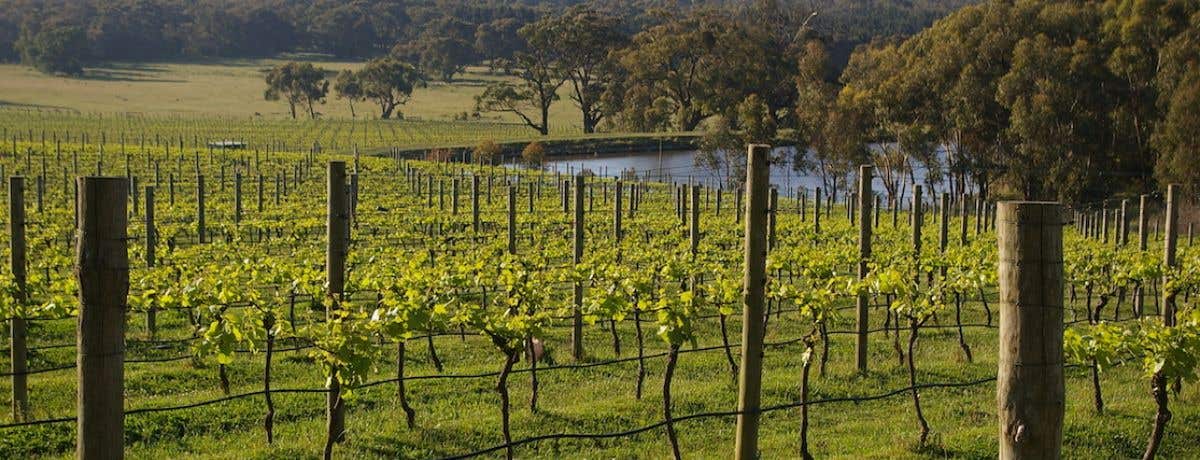Victoria

Wine was once extremely important to the state of Victoria, but phylloxera struck in the late 19th century and many of its scattered vineyards were abandoned. Even today, the Victorian wine map is more disjointed than that of any other Australian state, although the great bulk of its production comes from the Murray Darling vineyards irrigated by the Murray River – not that far upriver of South Australia's Riverland (which produces twice as much wine) and straddling the Victoria–New South Wales border. Here Lindeman's base at Karadoc in Mildura turns out oceans of its Bin 65 branded Chardonnay each year.
The real interest of Victoria to the fine wine drinker, however, are the vineyards in the southern half of the state, which is the coolest part of mainland Australia. The cloudy Yarra Valley just north east of Melbourne has been making top-quality wine for a century and has earned itself a reputation for delicate Pinot Noirs and Chardonnays such as those from De Bortoli, Yering Station, Tarrawarra, Diamond Valley and Giant Steps, excellent sparkling wine at Domaine Chandon (Green Point is the export label), and thoroughly complex Cabernet from Yarra Yering and the historic Yeringberg estate. Yarra Shiraz is distinctively cool-climate style.
On the other side of Melbourne and cooled by Port Phillip Bay, is Geelong, which has also shown an aptitude for Pinot Noir in bottlings from Bannockburn, By Farr and Scotchmans Hill, among others. And Melbourne can boast a third wine region within easy striking distance, on the Mornington Pensinsula due south across the Port Phillip Bay from Geelong. A tight-knit group of small estates such as Dromana, Main Ridge, Stonier, Ten Minutes by Tractor and T’Gallant have worked hard here to promote the reputation of this cool-climate wine region, which makes particularly crystalline Pinot Noir and Chardonnay.
To the north and west of Melbourne are a clutch of newly minted wine regions. Henty is the coolest of the three regions in western Victoria. Seppelt were the pioneers, Crawford River produce top-quality ageworthy Riesling and Tarrington have shown the region’s potential for burgundian varieties.
Great Western, an unofficial subregion of the Grampians, was also made famous by Seppelts, who have a Champagne-like honeycomb of sparkling wine cellars there, but Best's and, especially, Mount Langhi Giran make great still wines (notably peppery Shiraz and taut Riesling) nearby.
The high Pyrenees to the north east can boast Redbank, Taltarni and Dalwhinnie's best bottles as evidence of the potential of this cool area. Bendigo is much warmer, enabling Balgownie and others to produce sumptuous reds. Neighbouring Heathcote was brought to prominence by Jasper Hill and now has a reputation for rich Shiraz. The vineyards of the Macedon Ranges can be almost too cool but not for Chardonnay and Pinot Noir in the hands of producers such as Curly Flat and Bindi.
The Goulburn Valley is rather warmer and the Nagambie Lakes region within it houses two of Victoria's most commercially notable wineries, Mitchelton and the historic Chateau Tahbilk. Both make a wide range of varietals but Marsanne is a local speciality.
But Victoria's glory – indeed one of Australia's great gifts to the wine world – is to be found right up on the border with New South Wales, where Rutherglen and Glenrowan are sources of a unique style of rich fortified wines made from both a dark-skinned version of the best Muscat vine and from Muscadelle grapes, once labelled Tokay here but now known as Topaque. Ultra-ripe grapes are picked, part fermented, the wine is fortified (as in port production) and the result is matured for decades in small oak barrels in baking hot sheds so that the wines are like ultra-syrupy, grapey Banyuls with a touch of Madeira. Bailey’s, Chambers Rosewood, Morris, and Stanton & Killeen are some of the best-known producers. Milawa in neighbouring King Valley is the home of Brown Brothers, who have done much to vary Australia's varietal mix.